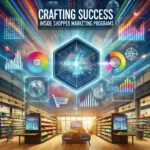Mastering Shopper Marketing: Strategies for Success in the Digital Age
In today’s digital age, shopper marketing has evolved significantly, driven by technological advancements and changing consumer behaviors. The traditional approach of merely attracting customers to physical stores is no longer sufficient. Instead, brands must engage shoppers across multiple touchpoints and create seamless experiences both online and offline. Here are key strategies to master shopper marketing in this dynamic environment:
1. **Leverage Data Analytics for Personalization**
Data is the cornerstone of modern shopper marketing. By leveraging data analytics, marketers can gain insights into consumer preferences, buying patterns, and behaviors. This allows for personalized marketing efforts that resonate with individual shoppers. Utilize customer data platforms (CDPs) to integrate data from various sources and create a single customer view, enabling precise targeting and personalized messaging.
2. **Omnichannel Integration**
An effective shopper marketing strategy requires an omnichannel approach. Shoppers expect a unified experience whether they are browsing online, using a mobile app, or visiting a physical store. Ensure consistency in branding, messaging, and promotions across all channels. Use technology such as QR codes and mobile apps to bridge the gap between digital and physical interactions.
3. **Enhance Mobile Shopping Experience**
With the rise of mobile commerce, ensuring a smooth mobile shopping experience is crucial. Optimize mobile apps and websites for speed and ease of use. Consider features like mobile wallets, one-click purchasing, and location-based offers to engage shoppers on the go. Mobile-optimized content drives engagement and conversion rates, making it an essential component of shopper marketing.
4. **Incorporate Social Commerce**
Social media platforms are increasingly becoming central to shopping journeys. Leverage social commerce tools to allow shoppers to browse and purchase directly within social platforms. Engage with consumers through interactive content, influencer partnerships, and shoppable posts. This creates a seamless transition from inspiration to purchase, enhancing the consumer journey.
5. **Utilize Artificial Intelligence and Machine Learning**
AI and machine learning offer powerful tools for enhancing shopper marketing efforts. From chatbots providing instant customer service to AI-driven product recommendations, these technologies can significantly improve customer experiences and increase sales. Predictive analytics can also help anticipate consumer needs, allowing marketers to proactively address demands.
6. **Focus on Sustainability and Ethics**
Modern consumers are increasingly conscious of sustainability and ethical considerations. Brands that demonstrate a commitment to social responsibility are more likely to attract and retain customers. Incorporate sustainable practices into your marketing strategies, such as eco-friendly packaging, transparent supply chains, and ethical labor practices. Communicate these initiatives clearly to build trust and loyalty.
7. **Measure and Optimize Continuously**
Finally, continuous measurement and optimization are critical to the success of any shopper marketing strategy. Use key performance indicators (KPIs) to track the effectiveness of campaigns and identify areas for improvement. Employ A/B testing to refine messaging and offers. Adapt quickly to changes in consumer behavior and market conditions to maintain a competitive edge.









5 thoughts on “Mastering Shopper Marketing: Strategies for Success in the Digital Age”